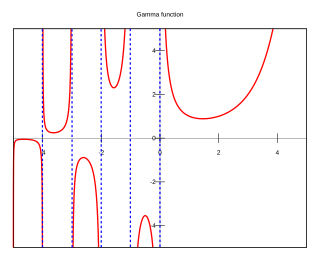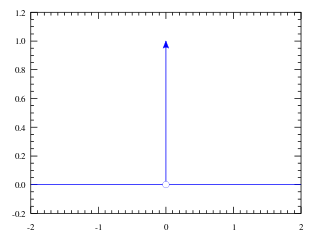
Bessel functions, first defined by the mathematician Daniel Bernoulli and then generalized by Friedrich Bessel, are canonical solutions y(x) of Bessel's differential equation for an arbitrary complex number , which represents the order of the Bessel function. Although and produce the same differential equation, it is conventional to define different Bessel functions for these two values in such a way that the Bessel functions are mostly smooth functions of .

In mathematics, the gamma function is the most common extension of the factorial function to complex numbers. Derived by Daniel Bernoulli, the gamma function is defined for all complex numbers except non-positive integers, and for every positive integer , The gamma function can be defined via a convergent improper integral for complex numbers with positive real part:

In mathematics, a holomorphic function is a complex-valued function of one or more complex variables that is complex differentiable in a neighbourhood of each point in a domain in complex coordinate space . The existence of a complex derivative in a neighbourhood is a very strong condition: It implies that a holomorphic function is infinitely differentiable and locally equal to its own Taylor series. Holomorphic functions are the central objects of study in complex analysis.

In mathematical analysis, the Dirac delta function, also known as the unit impulse, is a generalized function on the real numbers, whose value is zero everywhere except at zero, and whose integral over the entire real line is equal to one. Thus it can be represented heuristically as

In calculus, Taylor's theorem gives an approximation of a -times differentiable function around a given point by a polynomial of degree , called the -th-order Taylor polynomial. For a smooth function, the Taylor polynomial is the truncation at the order of the Taylor series of the function. The first-order Taylor polynomial is the linear approximation of the function, and the second-order Taylor polynomial is often referred to as the quadratic approximation. There are several versions of Taylor's theorem, some giving explicit estimates of the approximation error of the function by its Taylor polynomial.

In mathematics, the Fourier transform (FT) is an integral transform that takes a function as input and outputs another function that describes the extent to which various frequencies are present in the original function. The output of the transform is a complex-valued function of frequency. The term Fourier transform refers to both this complex-valued function and the mathematical operation. When a distinction needs to be made, the output of the operation is sometimes called the frequency domain representation of the original function. The Fourier transform is analogous to decomposing the sound of a musical chord into the intensities of its constituent pitches.
In calculus, and more generally in mathematical analysis, integration by parts or partial integration is a process that finds the integral of a product of functions in terms of the integral of the product of their derivative and antiderivative. It is frequently used to transform the antiderivative of a product of functions into an antiderivative for which a solution can be more easily found. The rule can be thought of as an integral version of the product rule of differentiation; it is indeed derived using the product rule.
In mathematical analysis, Parseval's identity, named after Marc-Antoine Parseval, is a fundamental result on the summability of the Fourier series of a function. The identity asserts the equality of the energy of a periodic signal and the energy of its frequency domain representation. Geometrically, it is a generalized Pythagorean theorem for inner-product spaces.
In the mathematical field of complex analysis, contour integration is a method of evaluating certain integrals along paths in the complex plane.

In mathematics, the parabolic cylinder functions are special functions defined as solutions to the differential equation
In mathematics, and specifically in potential theory, the Poisson kernel is an integral kernel, used for solving the two-dimensional Laplace equation, given Dirichlet boundary conditions on the unit disk. The kernel can be understood as the derivative of the Green's function for the Laplace equation. It is named for Siméon Poisson.
In mathematics, in particular in algebraic geometry and differential geometry, Dolbeault cohomology (named after Pierre Dolbeault) is an analog of de Rham cohomology for complex manifolds. Let M be a complex manifold. Then the Dolbeault cohomology groups depend on a pair of integers p and q and are realized as a subquotient of the space of complex differential forms of degree (p,q).
In mathematics, a reflection formula or reflection relation for a function f is a relationship between f(a − x) and f(x). It is a special case of a functional equation. It is common in mathematical literature to use the term "functional equation" for what are specifically reflection formulae.
Bilinear time–frequency distributions, or quadratic time–frequency distributions, arise in a sub-field of signal analysis and signal processing called time–frequency signal processing, and, in the statistical analysis of time series data. Such methods are used where one needs to deal with a situation where the frequency composition of a signal may be changing over time; this sub-field used to be called time–frequency signal analysis, and is now more often called time–frequency signal processing due to the progress in using these methods to a wide range of signal-processing problems.

In general relativity, a point mass deflects a light ray with impact parameter by an angle approximately equal to
In mathematics, particularly differential topology, the double tangent bundle or the second tangent bundle refers to the tangent bundle (TTM,πTTM,TM) of the total space TM of the tangent bundle (TM,πTM,M) of a smooth manifold M . A note on notation: in this article, we denote projection maps by their domains, e.g., πTTM : TTM → TM. Some authors index these maps by their ranges instead, so for them, that map would be written πTM.

In probability theory and directional statistics, a wrapped Cauchy distribution is a wrapped probability distribution that results from the "wrapping" of the Cauchy distribution around the unit circle. The Cauchy distribution is sometimes known as a Lorentzian distribution, and the wrapped Cauchy distribution may sometimes be referred to as a wrapped Lorentzian distribution.
In mathematical analysis and its applications, a function of several real variables or real multivariate function is a function with more than one argument, with all arguments being real variables. This concept extends the idea of a function of a real variable to several variables. The "input" variables take real values, while the "output", also called the "value of the function", may be real or complex. However, the study of the complex-valued functions may be easily reduced to the study of the real-valued functions, by considering the real and imaginary parts of the complex function; therefore, unless explicitly specified, only real-valued functions will be considered in this article.
In abstract algebra, the Virasoro group or Bott–Virasoro group is an infinite-dimensional Lie group defined as the universal central extension of the group of diffeomorphisms of the circle. The corresponding Lie algebra is the Virasoro algebra, which has a key role in conformal field theory (CFT) and string theory.
In mathematics, Cauchy wavelets are a family of continuous wavelets, used in the continuous wavelet transform.



















